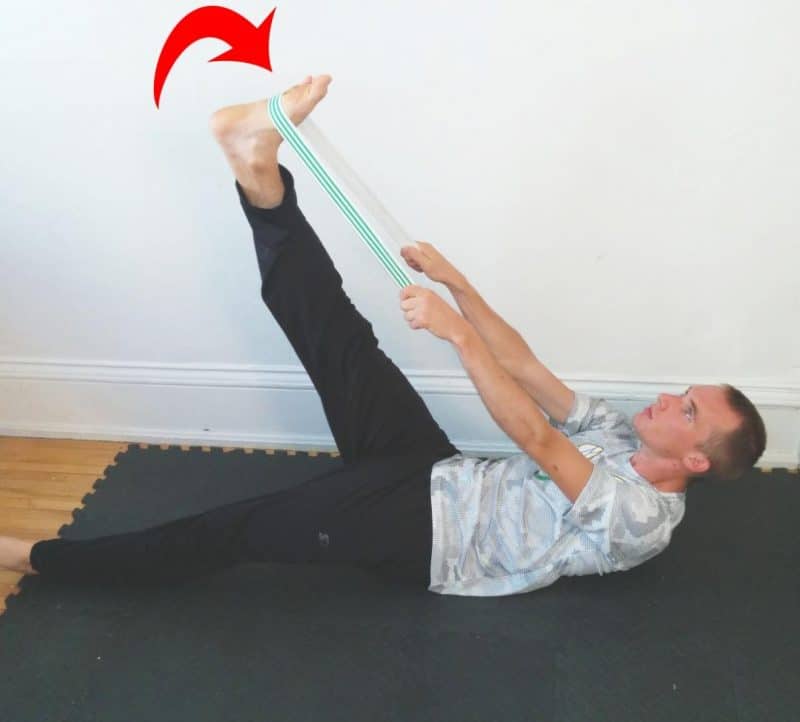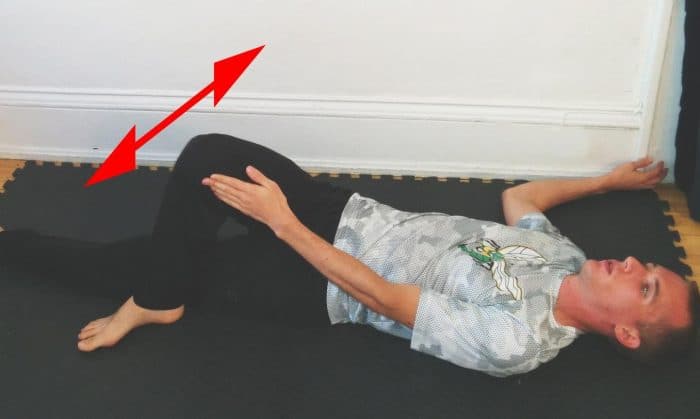Sciatica can be a pain in the butt…and the back…thigh…calf…even foot.
That may be a pun, but it has a lot of truth in it. Running with sciatica can make running almost unbearable, and a sciatica flare up can make us wonder will I ever run again?
Today, we are going to look into how the sciatic nerve causes pain while running, how you can treat the numbness of sciatica and running, while finding a solution to make sure it is safe to run in the future. Finally, we will answer the question that every runner will be wondering; can I run with sciatica?
Is it sciatica you are struggling with?
Let’s find out:
How is it possible for one injury to cause pain in so many places?
Unlike the most common running injuries, sciatica is a nerve problem.
Where does the sciatic nerve run?
 The sciatic nerve, from which the term “sciatica” originates, is an enormous structure that runs from your lower back through your glutes, down your hamstrings and calves, and into your foot.
The sciatic nerve, from which the term “sciatica” originates, is an enormous structure that runs from your lower back through your glutes, down your hamstrings and calves, and into your foot.It controls muscular activation for practically the entire posterior chain, i.e. the muscles on the back-side of your lower body.
These muscles are the prime movers for runners, so any disturbance to the sciatic nerve is bad news, and why running with sciatica pain is so dehabilitating.
Because of the nerve’s tremendous length, the symptoms of sciatica are myriad.
Running with sciatica nerve pain can become almost impossible, as it presents itself as a shooting, aching, or radiating pain anywhere along the sciatic nerve.
Most often, however, pain is felt in the lower back, tailbone area, and glutes, and pain may sometimes radiate down the hamstring.
In more rare cases, the pain can radiate into the calf and even the underside of the foot. Sciatic calf pain can get worse after prolonged sitting or with internal rotation of the leg, but this is not always the case.
Does Running Aggravate Sciatica (and How Do I Know If It Is Sciatica)?
One standard diagnostic test is the single-leg raise.While lying flat on the ground, have an assistant raise your leg up (or use a rope) on the affected side, keeping your knee straight.

The test is considered positive if the maneuver provokes lower back or sciatic nerve pain.
This straight leg raise will often reproduce sciatic nerve pain if the cause is a herniated disc
Another manual test that can often reproduce sciatic nerve pain involves lying on your back while bending the knee on the affected side.
Plant affected side’s foot on the opposite side of the body (i.e. on the outside of the opposite knee), and attempt to internally and externally rotate the affected leg against resistance. In most cases, this will reproduce pain as well.

Abduction or adduction of the bent and internally rotated leg against external resistance can often reproduce sciatic pain originating from the piriformis.
Is sciatica always the cause of lower back pain?
Historically, the cause of sciatica was assumed to be a herniated disc in the lower back.When a disc bulges out of the spine, it can press on the sciatic nerve and cause shooting pain along the nerve.
Indeed, according to a medical paper by Aaron G. Filler and other doctors at UCLA, the single leg raise is almost always positive when sciatica is caused by a herniated lumbar spine disc.2
However, a large number of people with sciatica don’t have a herniated disc, or if they do, it isn’t the cause of their pain—doctors note that somewhere around 40% of healthy, pain-free people have herniated discs as well.
In many ways, sciatica is really more of a symptom than an injury itself.
What are the running with sciatica symptoms?
Herniation of a lumbar spine disc can cause sciatic nerve pain, but so can a number of other conditions which have been detailed in the medical literature.First among these is piriformis syndrome, a somewhat-nebulous term that’s often used to refer to cases of sciatic nerve pain that do not appear to involve the lumbar spine.
Filler et al. write that MRI scans are very accurate at diagnosing or ruling out involvement of the piriformis muscle as the cause of sciatic nerve pain.
If you’ve determined your sciatica is related to your piriformis, you should see our companion article on piriformis syndrome.
Rarer causes of sciatica include stress fractures of the sacrum, avulsion fractures to the ischial tuberosity (the attachment point on the pelvis for the hamstring muscles), and fibrous tissue in the upper part of the hamstring muscle.
If your pain may be a hamstring issue, we have a great discussion about what others have tried on our hamstring tendonitis article.
How Common is Running with Sciatica?
Among distance runners, sciatica is not particularly common.
According to one study of over 2,000 injured runners, injuries to the spine, gluteus medius area, and hamstrings constituted only about eight percent of all running injuries—and of course sciatica of any type accounts for only some fraction of this.
Another study of injured runners pegs lower back problems (including sciatica, but also run-of-the-mill back pain) at 4.4% of all running injuries among marathoners.
As a result of the relative rarity and difficulty of identifying a specific cause, risk factors for sciatica are hard to pinpoint.
Data from studies on the general population show that frequent heavy lifting is a risk factor for sciatica—lifting heavy weights at the gym with improper technique might be one culprit for distance runners.
For unknown reasons, simply being tall appears to put you at risk of sciatica related to a herniated disc, though strangely, it does not seem to increase your risk of other lower back problems.
Among women, having given birth is a possible risk factor as well.
Effective Sciatica Treatment and Relief
Because it is somewhat rare among runners, there are not many high-quality studies on treatment protocols for sciatic nerve irritation.A proper diagnosis of the cause of the nerve irritation should always be the first course of action.
Medical examination by a doctor, sometimes combined with an MRI of the lower back and pelvis area, should be able to identify the root cause of the nerve pain.
Sciatica treatment exercises
In many cases, physical therapy can be helpful.Because there are no set protocols on managing sciatica, however it arises, seeing an experienced therapist who is accustomed to working with distance runners is your best bet.
For piriformis-related sciatica, rehab exercises will likely focus on glute strength, including the abductors and external rotators of the hip.
This usually involves the familiar family of hip strength work for runners: side leg lifts, clamshells, glute bridges, and theraband work.
For sciatica arising from a lower back problem, rehab more often entails stretching and strengthening exercises for the abs and back muscles.
Given that inflammation is often a factor in sciatic nerve irritation, this is one case in which a nonsteroidal anti-inflammatory drug like ibuprofen or naproxen can be useful.
A 2011 review article by Ryan Petering and Charles Webb at Oregon Health and Sciences University reviewed the medical literature on treatments for lower back pain in athletes, concluding that NSAIDs were one of the few treatments with fairly solid evidence supporting their use.
However, if the cause of sciatica is proven to be a bone stress injury, taking an anti-inflammatories is not a good idea.
Do injections for sciatica pain work?
Injections of anti-inflammatory medications into the painful area are another fairly common treatment; these are sometimes also co-opted as a method of diagnosis.For example, if an MRI shows that an aggravated piriformis muscle may be impinging on your sciatic nerve, your doctor can inject a numbing agent or a corticosteroid to reduce pain and attack the inflammation that’s causing pressure on the sciatic nerve.2
If a short-acting numbing agent reduces your pain, it’s clear that the location targeted by the injection is the culprit.
When to consider surgery for sciatica
As a last resort, surgery is an option for recalcitrant cases.While the viability of surgery is a very individual matter, one study did find that, although patients with sciatica who underwent an early surgery recovered more rapidly than those who elected conservative treatment, there was no difference in outcomes after one year, and 95% of both groups considered themselves recovered.
As such, you should allot plenty of time for conservative treatments before considering surgery.
Sciatica Pain: Will I Ever Run Again?
Though the pain associated with sciatica can hugely impede your ability to run, the good news is that the vast majority of people do recover.The recovery process can be lengthy, but with a good rehab program that addresses the root cause of your sciatic nerve pain, you should be able to gradually return to running.
Unlike other running injuries, like tendonitis or a stress fracture, it’s hard to give definitive guidelines on how much time off you’ll need or how quickly you’ll heal up.
Here’s the deal:
The recovery program for sciatica caused by a herniated disc is different from that of sciatica caused by piriformis syndrome, for example.
The diverse causes of sciatica mean that your recovery profile is going to be highly individual.
You might be back on your feet in a week or two, or it could take several months.
In any case, your best shot at recovery is accurately determining what’s causing your sciatic nerve pain, finding out if your state allows direct physical therapy access, and tailoring a rehab program to address it.
https://runnersconnect.net/running-injury-prevention/sciatica/
No comments:
Post a Comment